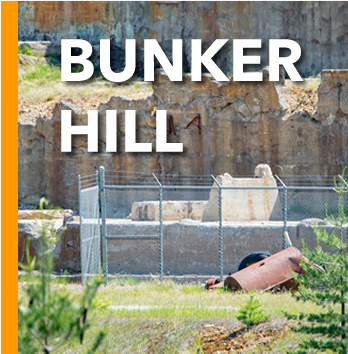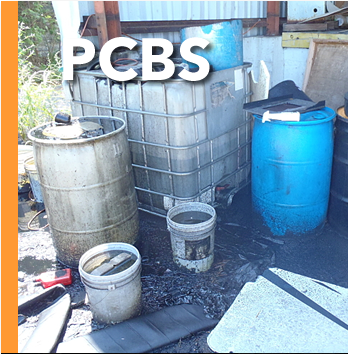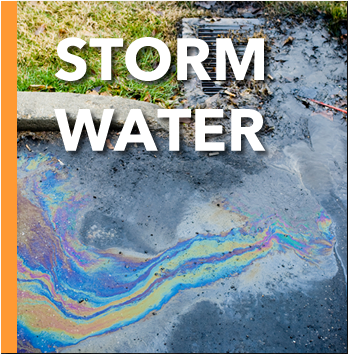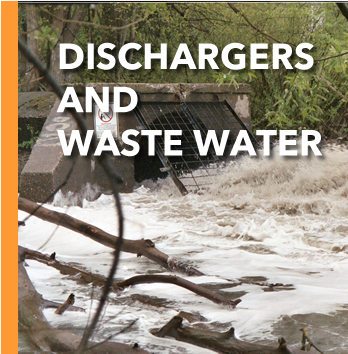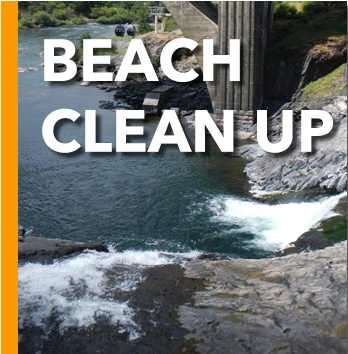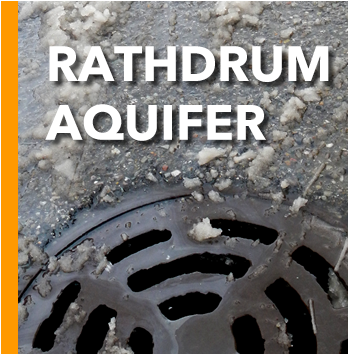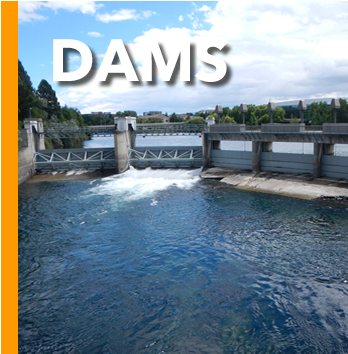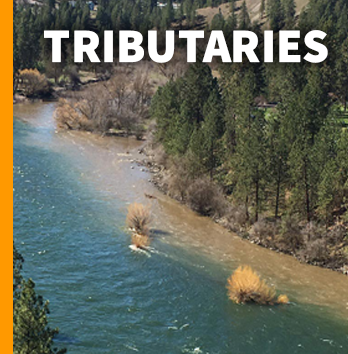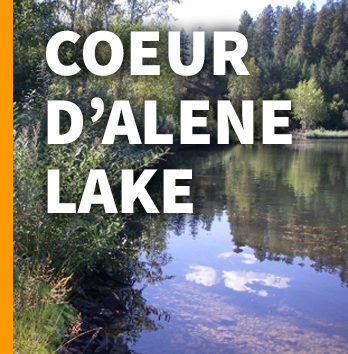Once Upon a Time
The region’s first processing mill—where minerals were crushed or stamped into small particles—was built in 1886. The tailings left over contained high lead and zinc concentrations along with other toxic metals such as copper, arsenic, cadmium, antimony, and mercury. During these early years, however, there were no laws preventing pollution, and the long-term toxic effects of discarded mine tailings were not well understood. In this era, most industrialists thought that the role of government was to encourage the development and exploitation of natural resources for private gain, and that is what happened.
By 1900, massive deposits of discarded metal tailings and slimes had reached agricultural areas below the Cataldo Mission in Idaho, and had begun to clog river channels. Farmers complained that tailings were poisoning their crops, livestock, dogs, and chickens. Small wooden impounding dams were built on the creeks above Wallace, to try to reduce the amounts of tailings and slimes transported downstream. These structures routinely failed, though, and tailings often spilled over during floods. Water pollution continued mostly unabated. By the late 1920s, tailings had polluted the lower reaches of the Coeur d’Alene River, Lake Coeur d’Alene, and the Spokane River.
The first recorded water samplings were taken in 1931. It was discovered that under normal conditions, the lake water was almost saturated with lead in solution. Lead concentrations in Harrison, Idaho, ranged as high as 2.25 parts per million (ppm); the City of Coeur d’Alene clocked in at 1.75ppm. By comparison: the federal drinking water standard for lead at the time was not to exceed 0.1 ppm, so water drunk from the lake contained lead levels over twenty times higher than the national standard.
By 1932, the 50-mile long South Fork of the Coeur d’Alene River was found to be practically devoid of fish, macro-invertebrates, or plankton organisms. To try to reduce water lead levels, a huge floating suction dredge was built on Mission Flats, near Cataldo. Water containing tailings was pumped into a series of ponds and sloughs; after the sediment had settled, the water was returned to the river. Although this helped abate pollution to some extent, pollution of the lower river was not remediated. The dredge continued to operate every summer for the next 35 years, and even despite this, it is estimated that about 55,000 thousand tons of lead were deposited on Mission Flats, and an additional 117,000 tons of lead were deposited on downstream flood plains. For decades, the area was a toxic, barren, desert-like landscape covered with tailings.


Attempts at Repair
The federal Water Pollution Control Act of 1948 was the first comprehensive federal legislation to establish legal authority for regulating water quality. Air pollution control lagged yet further behind. In 1955, Bunker Hill began monitoring lead emissions from their lead smelter stack for the first time, but their data was withheld from federal agencies until much later. The data showed that from 1955 to 1959, average lead emissions were estimated to be 100 tons per year.
Bunker Hill first started containing mine tailings in the 1920s. The Central Impoundment Area (CIA) tailings pond was built in the 1920s as a first effort to contain the tailings. By 1969, it had grown to 169 acres. However, waste streams from the mine and mill that were discharged into the CIA were often diverted into adjacent creeks flowing into the South Fork.
By the 1960s, federal water pollution acts required district mining companies to cease polluting the Coeur d’Alene River with mine and mill wastes and sewage. At that time, there were 17,000 people living in the valley, and no sewage treatment facilities existed until the 1970s.
Consequences
No meaningful air pollution control acts were passed until the 1970s, when regulating lead in the atmosphere became a dominant issue that would significantly impact the U.S. lead industry. The health effects associated with lead are the same whether it enters the body through breathing or swallowing. Lead can affect almost every organ and system in the body, especially the nervous system. No safe level of lead exposure has been determined.
Concern about lead poisoning in workers and families prompted the Idaho Department of Health to study lead in air, soil, and vegetation, and a screening program for Kellogg residents was initiated in 1973. Respirators were first required in 1973. In what was regarded by some as a breach of medical ethics, the company commissioned a urine study of area children without their parents’ knowledge or consent.
In 1973, a fire burned two of seven sections of the Bunker Hill baghouse (a pollution control device) and part of its roof. The company did not repair the baghouse, and lead emissions tripled in the following months. During this time, lead prices rose from $286 to $479 per ton. Only a month after the baghouse repair was finally completed, two children were hospitalized for lead poisoning, and an investigation showed a fourfold increase in lead levels around the smelter over the preceding two years.
Some of the highest levels of blood lead in the country were measured in children living near the Bunker Hill Smelter. Approximately 26% of the two-year-olds in the region had dangerously high levels of lead in their blood, which had long-term negative consequences for their health, especially intellectual functioning and achievement. Children’s blood-lead levels in the Silver Valley have declined dramatically since the 1970s, when the Bunker Hill smelter was operating without pollution controls.
Meanwhile, mine and smelter tailings had been used for years as landfill and to sand icy streets. The grounds of the Silver King High School – located just across the street from the smelter – were discovered to be heavily contaminated. The school board voted to close the school, but citizens voted to keep the school open. In 1977, nine children sued Bunker Hill for $20 million for health problems due to lead poisoning that had occurred in 1973, and in 1981, the company paid a $2 million settlement to a family whose three children had been “leaded.”
Cleanup
In June 1980, the U.S. Court of Appeals upheld the Environmental Protection Agency (EPA) ambient air quality standard for lead of 1.5 micrograms/meter; Bunker Hill and other lead producers insisted that 5.0 micrograms was the most reasonable standard that could be met. Bunker Hill spent over $20 million for pollution control, and still couldn’t comply. In early 1982, the mine and smelter were closed and 2,000 people lost their jobs. The EPA designated the 21 acres surrounding the smelter as a federal superfund site.
In 1983, the Bunker Hill smelter was added to the EPA’s National Priorities List as a Superfund site. As of 2007, the EPA had spent $200 million attempting to remediate the site, much of which was spent removing contaminated topsoil from residential areas. The State of Idaho had also spent funds since the early 1980s on cleanup. While there were measurable improvements in environmental conditions, a vast amount of cleanup and restoration was still required.
Specific cleanup strategies have included removing and replacing surface soil in people’s yards, public playgrounds, parks, commercial properties, and moving them into safe storage areas, known as repositories. It also includes cleaning up mine waste at non-operating mine and mill sites in the Upper Basin. Other examples of activities include paving certain roads to prevent contamination, taking steps to keep cleaned up areas clean, and continuing public outreach and education.
All the soil and contaminated debris from cleanups of residential and commercial properties contains metals - such as lead and arsenic - that can harm people. All these materials have been placed in waste repositories, which are engineered sites that contain contaminated materials. These sites are monitored long after they are closed to be sure the contaminants remain contained and secure.
During 2018, the Bunker Hill Central Treatment Plant will undergo improvements and upgrades, and a groundwater collection and treatment system is being installed. Activities to construct a new sludge holding area on top of the CIA began in April 2018. When the construction is complete, there will be much less metals pollution going into the South Fork of the Coeur d’Alene River.
Further Reading
- Link to Bunker Hill superfund site:
https://cumulis.epa.gov/supercpad/cursites/csitinfo.cfm?id=1000195 - Link to WA state cleanup sites:
https://ecology.wa.gov/Spills-Cleanup/Contamination-cleanup/Cleanup-sites/Toxic-cleanup-sites
This project is supported by funds from the Washington State Department of Ecology.

